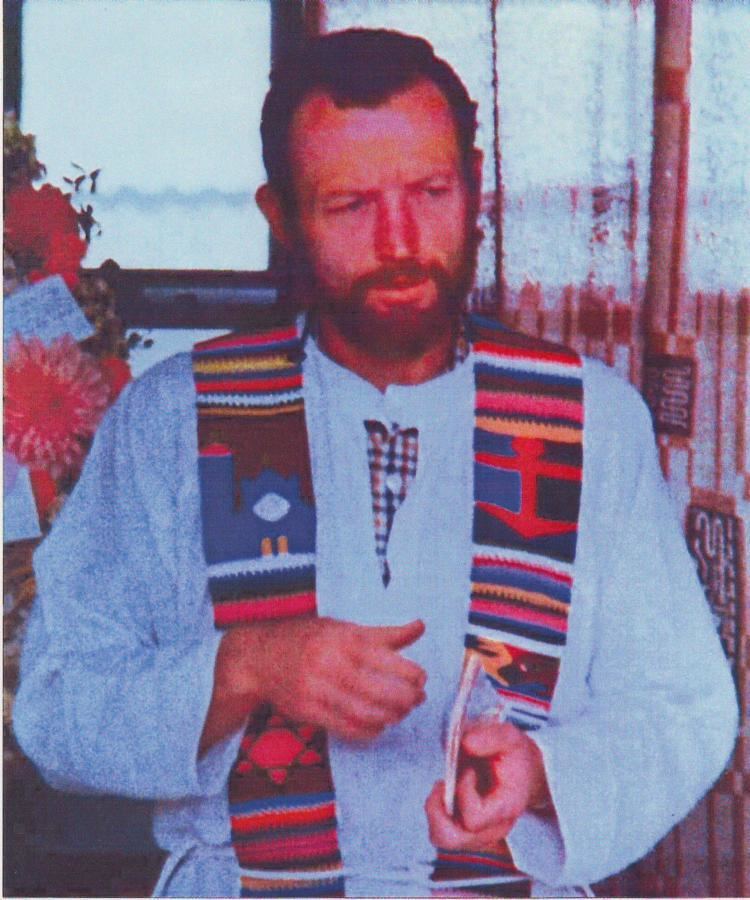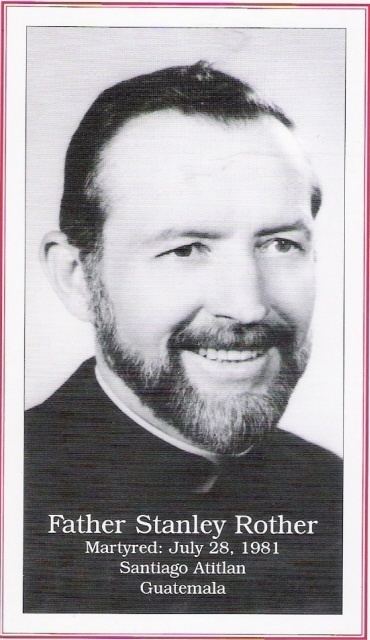Nationality American Role Priest Name Stanley Rother | Title as Saint Priest and martyr Denomination Roman Catholic | |
 | ||
Ordination May 25, 1963by Victor Reed Alma mater Mount St. Mary's University Education Mount St. Mary's University Place of burial Okarche, Oklahoma, United States Parents Franz Rother, Gertrude Smith Rother | ||
Fr stanley rother cause for sainthood al kresta interviews fr price oswalt
Blessed Stanley Francis Rother (March 27, 1935 – July 28, 1981) was an American Roman Catholic priest from Oklahoma who was martyred in Guatemala. Ordained as a priest for the Archdiocese of Oklahoma City in 1963, he held several parish assignments there until 1968 when he was assigned as a missionary priest to Guatemala where he was murdered in 1981 in his Guatemalan mission rectory.
Contents
- Fr stanley rother cause for sainthood al kresta interviews fr price oswalt
- Farmer Priest and Martyr
- Education and priesthood
- Guatemalan pastor
- Final months and murder
- Beatification
- References

On December 1, 2016, Pope Francis issued a decree confirming that he had been killed "in odium fidei" (in hatred of the faith) which would allow him to be beatified. Rother was beatified on September 23, 2017, during a Mass at the Cox Convention Center in Oklahoma City. He is the first US-born priest and martyr to be beatified by the Catholic Church and the second person to be beatified on US soil following the 2014 beatification of New Jersey-born nun Miriam Teresa Demjanovich.

Farmer, Priest, and Martyr
Education and priesthood

Stanley Francis Rother was born on March 27, 1935, in Okarche, as one of five children of Franz Rother (August 8, 1911 – July 2, 2000) and Gertrude Smith (May 23, 1913 – October 24, 1987), who had a farm close to that town in Oklahoma; he had two sisters and two brothers and was baptized on March 29, 1935, in Okarche's Holy Trinity church by Father Zenon Steber. His only surviving sibling is Marita Rother (b. 1937), a nun since 1956.

Stanley was strong and adept at farm tasks. Then after completing his high school studies at the Holy Trinity school he declared his calling to the priesthood to his parents. His parents were pleased with their son's decision though his father asked him: "Why didn't you take Latin instead of working so hard as a Future Farmer of America?" To prepare for this he was sent to the Saint John Seminary and then to Assumption Seminary in San Antonio in Texas. His talents gained working on the farm left him with other duties at the seminary, and his studies suffered; he struggled learning Latin. He served as a sacristan, groundskeeper, bookbinder, plumber, and gardener. After almost six years the seminary staff advised him to withdraw.
After consultation with his local bishop Victor Reed he then attended Mount Saint Mary's Seminary in Emmitsburg in Maryland from which he graduated in 1963. Rother accompanied his father and the Okarche pastor Edmund von Elm to see Bishop Reed who asked him: "Do you want to be a priest, Stanley?" He replied: "Yes, but it's all over for me, isn't it?" Reed told him that he saw potential in him and would send him to another seminary to see what became of it. The rector of the Maryland seminary George Mulcahy sent a letter to Reed on February 14, 1963 in which he said: "Mister Rother has made excellent progress at this seminary and he should be a very valuable parish priest." Reed ordained him to the priesthood on May 25, 1963. Rother then served as an associate pastor in various parishes around Oklahoma: Saint William's in Durant, Saint Francis Xavier and the Holy Family Cathedral in Tulsa, and Corpus Christi in Oklahoma City. In 1968 – at his own request – he was assigned to the mission of the archdiocese to the Tz'utujil people located in Santiago Atitlán in the rural highlands of southwest Guatemala. It was while he was at Corpus Christi that he had learned a priest was needed in Guatemala, and so applied and was accepted by Bishop Reed in 1968.
Guatemalan pastor
So that he could be in closer touch with his congregation, he set out to work to learn Spanish and the Tz’utujil language which was an unwritten and indigenous language that the missionary Ramón Carlín once recorded. He served in Santiago Atitlán from 1968 until his death. Rother lived with a native family for a while to get a better grasp of practical conversation, and worked with the locals to show them how to read and write. He supported a radio station located on the mission property which transmitted daily lessons in both language and mathematics. In 1973 he noted with pride in a letter: "I am now preaching in Tzutuhil." During that time, in addition to his pastoral duties he translated the New Testament into Tz'utujil and began the regular celebration of the Mass in Tz'utujil. In the late 1960s Rother founded in Panabaj a small hospital, dubbed as the "Hospitalito"; Father Carlín served as a collaborator in this project.
By 1975, Rother had become the de facto leader of the Oklahoma-sponsored mission effort in Guatemala as other religious and lay supporters rotated out of the program. He was a highly recognizable figure in the community, owing to his light complexion as well as his habit of smoking tobacco in a pipe. Since there was not a Tzutuhil name equivalent to "Stanley," the people of Father Rother's mission affectionately called him "Padre A'Plas," translated as "Father Francis," a nod to his middle name.
Rother put his farming skills to good use in Guatemala, on one occasion operating a bulldozer from 7:00 am to 4:30 pm to clear land on local farms, stopping just for Mass. His door was open to all people. There was one old man who appeared each day for lunch, and others came for advice on personal or financial affairs. Some even turned up to have their teeth extracted. On one occasion he accompanied a boy to Guatemala City to be treated for lip cancer, from which the boy was eventually cured.
Final months and murder
Within the last year of his life Rother saw the radio station smashed and its director murdered. His catechists and parishioners would disappear and later be found dead, with their bodies showing signs of having been beaten and tortured. Rother knew all this when he returned to Guatemala in May 1981. In December 1980 he had addressed a letter to the faithful in Oklahoma and wrote about the violent situation: "This is one of the reasons I have for staying in the face of physical harm. The shepherd cannot run at the first sign of danger."
At the beginning of 1981 he was warned that his name was on a death list (he was number eight on the list) and that he should leave Guatemala at once to remain alive. One parishioner warned him in January: "Father, you're in extreme danger. You must get out immediately." Rother was reluctant but he nonetheless returned to Oklahoma in January, though he later asked the archbishop for permission to return: "My people need me. I can't stay away from them any longer." Another reason for returning was that he wanted to celebrate Easter with them. His brother Tom said to him, upon hearing that Stanley wanted to return to Guatemala: "Why do you want to go back? They're waiting on you and they're gonna kill you." Rother said: "Well, a shepherd cannot run from his flock." Rother went back to Santiago Atitlán in April and knew that he was being watched.
On the morning of July 28 just after midnight, gunmen broke into the rectory of his church and shot him twice in the head after a brief struggle. The killers forced the teenager Francisco Bocel (who was in the church at the time) to lead them to the bedroom of the "red-bearded Oklahoma-born missionary." The men threatened to kill Bocel if he did not show them Rother and so Bocel led them downstairs and knocked on a door near the staircase saying: "Father. They are looking for you." Rother opened the door and a struggle ensued as Bocel ran upstairs hearing Rother yell: "Kill me here!" One shot pierced his jaw and the fatal shot struck the left temple; there were bruises on both hands. His father Franz – upon hearing the news of his son's death – rang his eldest daughter Marita in Kansas and told her: "They got him." She hung up the phone and wept. His brother Tom and his family were on a vacation in Memphis when they received the news.
Father Rother was one of 10 priests murdered in Guatemala that year. His remains were flown back to Oklahoma and were buried in his hometown on August 3, 1981, in Holy Trinity Cemetery. At the request of his former Tzutuhil parishioners, his heart was removed and buried under the altar of the church where he had served.
Three men were arrested on charges of murder within weeks of Rother's murder; another man and a women were sought for questioning at that stage as well. The three men arrested admitted to having entered the church in a robbery attempt, and also admitted to having shot Rother dead when the priest attempted to stop them. Despite the confessions, many people familiar with the circumstances of the murder considered the three accused persons as innocent, and the prosecutions to be a cover-up of paramilitary involvement in the murder. Convictions for all three men were later overturned by a Guatemalan appellate court, under pressure from U.S. authorities. No other suspects have been prosecuted for the murder.
Beatification
The beatification process was set to open in the Archdiocese of Oklahoma City but the cause had to first be transferred to the archdiocese from Guatemala because a cause opens in the diocese where the individual died; the forum transfer was granted from the Sololá-Chimaltenango diocese to Oklahoma on September 3, 2007. The diocesan process of investigation opened on October 5, 2007 and closed on July 20, 2010. The formal start to the cause came under Pope Benedict XVI on November 25, 2009 when Rother became titled as a Servant of God. The diocesan process received validation from the Congregation for the Causes of Saints on March 16, 2012 in Rome and later received the Positio dossier from the cause's officials in 2014. The theologians approved the cause in a unanimous decision on June 23, 2015 as did the cardinal and bishop members of the CCS on October 18, 2016.
On December 1, 2016 his beatification received approval from Pope Francis after the Pope confirmed that Rother had been killed "in odium fidei" (in hatred of the faith). On March 13, 2017 the date for his beatification was announced on the archdiocesan website. Rother was beatified on September 23, 2017 at the Cox Convention Center, with Cardinal Angelo Amato presiding over the beatification - as the Prefect of the Congregation of the Causes of the Saints on the pope's behalf at a mass attended by approximately 20,000 people. Among the Bishops who assisted Amato included the Most Rev. Paul S. Coakley, associate of Coakley, Archbishop of the Archdiocese of Oklahoma City and Oklahoma City Archbishop Emeritus Eusebius Beltran, who began Rother’s cause for canonization in 2007.
The postulator for the cause was Dr. Andrea Ambrosi.
